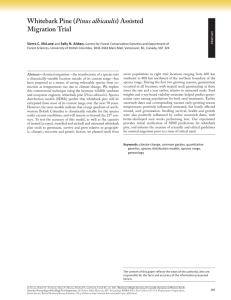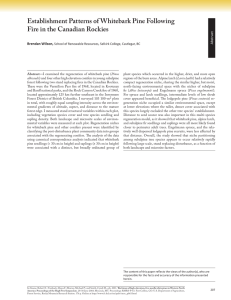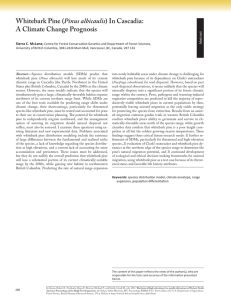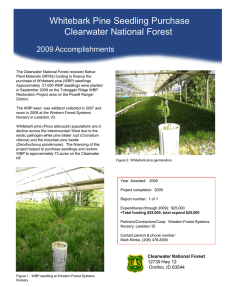Highlights of the Forest Health Protection Whitebark Pine Restoration Program Background Restoration Program
advertisement
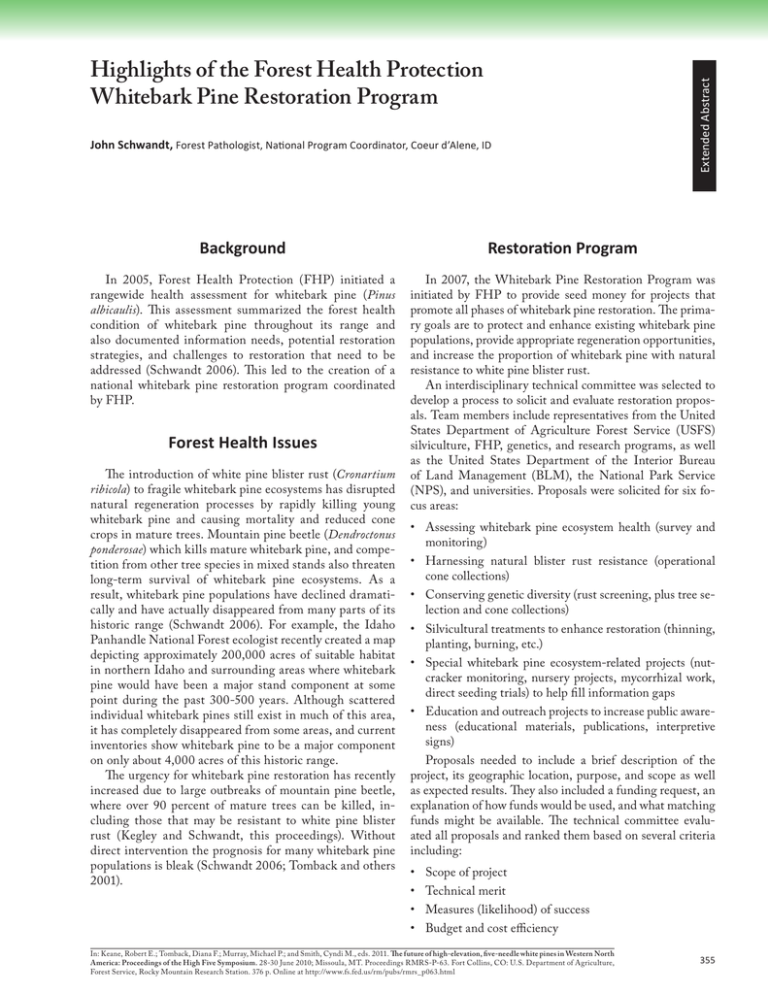
John Schwandt, Forest Pathologist, National Program Coordinator, Coeur d’Alene, ID Extended Abstract Highlights of the Forest Health Protection Whitebark Pine Restoration Program Background Restoration Program In 2005, Forest Health Protection (FHP) initiated a rangewide health assessment for whitebark pine (Pinus albicaulis). This assessment summarized the forest health condition of whitebark pine throughout its range and also documented information needs, potential restoration strategies, and challenges to restoration that need to be addressed (Schwandt 2006). This led to the creation of a national whitebark pine restoration program coordinated by FHP. In 2007, the Whitebark Pine Restoration Program was initiated by FHP to provide seed money for projects that promote all phases of whitebark pine restoration. The primary goals are to protect and enhance existing whitebark pine populations, provide appropriate regeneration opportunities, and increase the proportion of whitebark pine with natural resistance to white pine blister rust. An interdisciplinary technical committee was selected to develop a process to solicit and evaluate restoration proposals. Team members include representatives from the United States Department of Agriculture Forest Service (USFS) silviculture, FHP, genetics, and research programs, as well as the United States Department of the Interior Bureau of Land Management (BLM), the National Park Service (NPS), and universities. Proposals were solicited for six focus areas: Forest Health Issues The introduction of white pine blister rust (Cronartium ribicola) to fragile whitebark pine ecosystems has disrupted natural regeneration processes by rapidly killing young whitebark pine and causing mortality and reduced cone crops in mature trees. Mountain pine beetle (Dendroctonus ponderosae) which kills mature whitebark pine, and competition from other tree species in mixed stands also threaten long-term survival of whitebark pine ecosystems. As a result, whitebark pine populations have declined dramatically and have actually disappeared from many parts of its historic range (Schwandt 2006). For example, the Idaho Panhandle National Forest ecologist recently created a map depicting approximately 200,000 acres of suitable habitat in northern Idaho and surrounding areas where whitebark pine would have been a major stand component at some point during the past 300-500 years. Although scattered individual whitebark pines still exist in much of this area, it has completely disappeared from some areas, and current inventories show whitebark pine to be a major component on only about 4,000 acres of this historic range. The urgency for whitebark pine restoration has recently increased due to large outbreaks of mountain pine beetle, where over 90 percent of mature trees can be killed, including those that may be resistant to white pine blister rust (Kegley and Schwandt, this proceedings). Without direct intervention the prognosis for many whitebark pine populations is bleak (Schwandt 2006; Tomback and others 2001). • Assessing whitebark pine ecosystem health (survey and monitoring) • Harnessing natural blister rust resistance (operational cone collections) • Conserving genetic diversity (rust screening, plus tree selection and cone collections) • Silvicultural treatments to enhance restoration (thinning, planting, burning, etc.) • Special whitebark pine ecosystem-related projects (nutcracker monitoring, nursery projects, mycorrhizal work, direct seeding trials) to help fill information gaps • Education and outreach projects to increase public awareness (educational materials, publications, interpretive signs) Proposals needed to include a brief description of the project, its geographic location, purpose, and scope as well as expected results. They also included a funding request, an explanation of how funds would be used, and what matching funds might be available. The technical committee evaluated all proposals and ranked them based on several criteria including: • • • • Scope of project Technical merit Measures (likelihood) of success Budget and cost efficiency In: Keane, Robert E.; Tomback, Diana F.; Murray, Michael P.; and Smith, Cyndi M., eds. 2011. The future of high-elevation, five-needle white pines in Western North USDA Forest Service Proceedings RMRS-P-63. America: Proceedings of the High Five Symposium. 28-30 2011. June 2010; Missoula, MT. Proceedings RMRS-P-63. Fort Collins, CO: U.S. Department of Agriculture, Forest Service, Rocky Mountain Research Station. 376 p. Online at http://www.fs.fed.us/rm/pubs/rmrs_p063.html 355 Highlights of the Forest Health Protection… Proposals for gene conservation or with broad geographic and ecological application and including matching funds received highest priority. Program funding in 2007 and 2008 from the FHP Washington Office was $200,000 but additional FHP contributions from USFS Regions 1, 4, and 6 added an extra $67,320 in 2007 and $198,900 in 2008. In subsequent years, the base funding was reduced to $150,000 but USFS Regional contributions have more than doubled these amounts. The program is very popular and although requests far outweigh funding levels, the program has helped to fund more than 100 projects that have spent more than $3,000,000 on whitebark pine restoration projects throughout the western US (table 1). The success of this program is largely due to the tremendous support of a wide array of cooperators that have more than doubled the total FHP investment each year. Cooperators include state and private agencies, foundations, and universities as well as over 30 national forests across five USFS regions, 10 national parks (including three in Canada), and several native American tribes. Cooperators also include a broad spectrum of environmental and hunting groups as well as several ski areas. In 2009, the Whitebark Pine Ecosystem Foundation provided $30,000 that helped fund several whitebark pine planting projects, and in 2010 the program assisted American Forest Magazine with producing a special educational article and they set aside $10,000 to assist with planting projects. Future Plans program has been instrumental in assisting with surveys, cone collections, silvicultural treatments as well as educational and special projects to promote whitebark pine restoration. Whitebark pine is currently under consideration for listing as a threatened and endangered (T&E) species in both Canada and the United States (COSEWIC 2010, NRDC 2008). Whether listing as a T&E species helps or hinders the restoration process remains to be seen, but these activities will likely increase the level of interest in whitebark pine restoration. Regardless of the outcome of the T&E requests, successful restoration of whitebark pine will require long-term support and commitment to developing and implementing restoration strategies. Literature Cited COSEWIC. 2010. COSEWIC assessment and status report on the whitebark pine Pinus albicaulis in Canada. Committee on the Status of Endangered Wildlife in Canada. Ottawa. 55 p. NRDC. 2008. [Online]. A petition to list the whitebark pine, Pinus albicaulis, as an endangered species under the Endangered Species Act. 66 p. Available at: http://docs.nrdc.org/legislation/ files/leg_08120801a.pdf [2010, September]. Schwandt, J. W. 2006. Whitebark pine in peril: a case for restoration. Missoula, MT: U.S. Department of Agriculture Forest Service, Report R1-06-28. Tomback, D. F.; Arno, S. F.; Keane, R. E. 2001. The compelling case for management intervention. In: Tomback, D. F.; Arno, S. F.; Keane, R. E., eds. Whitebark pine communities: ecology and restoration. Washington, DC. Island Press: 3-25. Although the need for whitebark pine restoration activities far exceeds the current funding levels, the current Table 1. Whitebark pine restoration program funding history. # Proposals Received $$ Requested from FHP Total Matching Funds # Projects Funded Forest Health Funds Match for Funded Projects TOTAL FUNDS INVESTED Totals 2007 2008 20092010 211 4,661,135 3,824,302 106 1,448,032 1,782,358 3,230,390 56 1,005,700 850,500 24 267,320 291,700 559,020 64 1,981,134 1,202,290 26 398,900 433,850 832,750 52 960,851 878,532 35 481,612 444,683 926,295 39 713,450 892,980 21 300,200 612,125 912,325 Note: This table only lists projects that were submitted to this FHP sponsored program. The FHP western bark beetle program funds approximately $200,000 annually for projects dealing with protecting whitebark pine from mountain pine beetle, and there are additional FHP Monitoring and Special Technology Development projects that focus on whitebark pine. In addition, FHP initiated a Gene Conservation Program in 2010 to collect cones from five-needle pines. FHP is currently developing a Monitoring on the Margins program to identify and monitor critical populations of high elevation pines. Many national forests and other agencies also fund projects outside the purview of this program so the totals in this table represent only a portion of all funds spent on whitebark pine each year. The content of this paper reflects the views of the author(s), who are responsible for the facts and accuracy of the information presented herein. 356 USDA Forest Service Proceedings RMRS-P-63. 2011.
